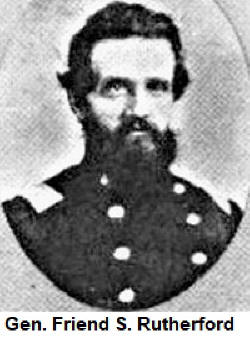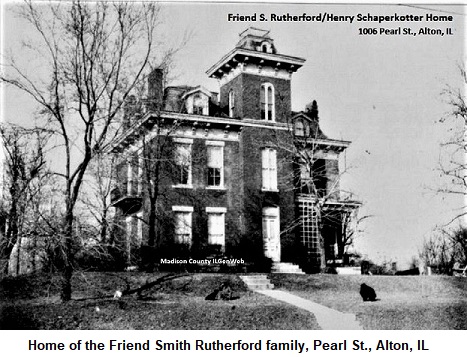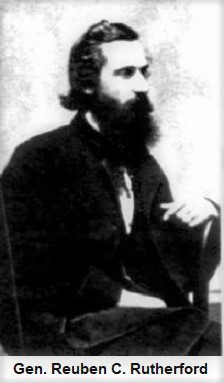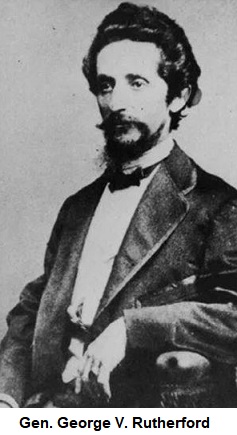Brigadier-General Friend Smith Rutherford (1820-1864)
Attorney; Brigadier-General in the Civil War

In his youth, Friend Rutherford was noted for a love of learning and
a quick, mechanical mind, which led him to the study of philosophy
and the practice of philosophical experiments. As he grew older, his
tastes became directed to intellectual pursuits, and he decided upon
the study of law. He pursued his legal studies at Troy, New York,
where he ranked well among his fellow students. Because of the
overuse of his eyes they became weak, and he was forced to end his
studies and take on a more active lifestyle. He engaged in erecting
telegraph lines for the American Telegraph Company, traveling
throughout the South, including Tennessee, Alabama, and Mississippi.
His health was restored, and following his marriage in 1849 to
Letitia V. Sloss of Alabama (on her eighteenth birthday), the young
couple moved to Edwardsville, Illinois, and Mr. Rutherford opened a
law practice with her brother (also an attorney), Joseph Sloss. The
couple lived in a home at Purcell and Second Street in Edwardsville,
near the present-day Madison County courthouse.
Friend Rutherford took on a prominent roll in politics, and
connected himself with the free-soil wing of the Democratic Party.
He was one of the first, however, to break party allegiance from the
Democrat Party, and joined the Republican Party. Rutherford was a
member of the Anti-Nebraska State Convention in 1856, with the aim
of preventing the State of Nebraska from introducing slavery into
their State. Rutherford is credited with helping Madison County
Sheriff Zephaniah B. Job face down a lynch mob in Edwardsville in
1857, when George Sharpe, Robert Sharpe, and John Johnson were on
trial for the murder of Franz Jacob Barth. Rutherford served as one
of three defense lawyers.
In 1858, Mr. Rutherford received an appointment of Superintendent of
the Alton State Prison. The family moved to Alton, Illinois, where
he lived for the remainder of his life. Rutherford was at the prison
when a prisoner by the name of Hall, convicted of murder, held a
guard, Clark C. Crabb, captive in his cell. The prisoner was armed
with a knife. Supervisor Rutherford and warden Samuel Buckmaster
devised a plan to free the guard, which they did, but not before the
guard was stabbed multiple times. Prisoner Hall was shot and killed
by warden Buckmaster.
Mr. Rutherford gave a speech in favor of Abraham Lincoln during the
Lincoln-Douglas Debate in Alton, on October 15, 1858. His
brother-in-law (and law partner), Joseph H. Sloss, gave a speech for
Stephen A. Douglas. Sloss later volunteered in the Confederate Army
during the Civil War, and was later elected as a representative in
the U.S. Congress.
In about 1860, Rutherford erected a Victorian three-story,
fourteen-room brick home at 2006 Pearl Street in Alton (northeast
corner of Pearl and Central Avenue). It featured ornate iron work
and a tower, topped with wrought iron railing and a side balcony.
The estate included a large barn with a stone foundation, chicken
coops, a grape arbor, and a large garden. The property extended from
Central Avenue to Garden Street, and Pearl Street to Royal Street.
This home later became the property of Mr. Henry Schaperkotter, who
owned a cooperage in St. Louis, and had bought out several small
barrel-making concerns in Alton. His son, Fred Schaperkotter, later
lived in the home and divided it into smaller apartments. He rented
the lower floor to Dr. Marion, a horse-and-buggy family doctor, who
delivered many of the Schaperkotter children in the house. Fred took
over the Alton cooperage, which prospered and became a major
supplier of barrels for the Stanard-Tilton Flour Mill (later Peavey
Mill). Some of the surrounding ground of the estate was divided and
sold for homes. The Rutherford home was razed in 1995, even though
it was on the National Register of Historic Places.

When the Civil War broke out, Mr. Rutherford enlisted in the
Army. He was made Captain Commissary of Subsistence, and served in
that capacity until September 2, 1862, when he resigned and assisted
in the organization of the 97th Illinois Infantry. This regiment was
organized at Camp Butler, Illinois, and on September 16, 1862,
Friend S. Rutherford was commissioned as its Colonel. This regiment
became part of the forces operating a campaign against Vicksburg,
and Colonel Rutherford and his regiment bore their full share in the
spirited engagement at Port Gibson. At the fierce battle of
Champion’s Hill, Colonel Rutherford had the unpleasant duty of
holding his regiment as a target for the Confederate artillery for
at least two hours, at a distance of not over 800 yards. The next
morning, he led his regiment on to the Black River, and took part in
the fight at that place. On May 19 and 22, he led the regiment in
both charges at Vicksburg, and they never failed to go as far as any
other regiment. He then took part in the contest at Jackson, and
under his leadership his regiment distinguished itself sufficiently
to be praised by Major-General William T. Sherman, who commanded the
expeditionary army. The remainder of his service was spent in
Louisiana, where his regiment performed guard duty. The long march
to Vicksburg caused ill health, and he was forced to apply for a
leave of absence. He left the battlefields for Alton, where he was
nursed back to health by a loving wife. He rejoined the Regiment,
but as the warm season advanced, his old disease of dysentery
returned, and it was evident to his friends that if he wished to
live, he should return home. He was unwilling to do so, and fought
ill health until he was forced by weakness to resign on June 15,
1864. He was replaced by Colonel Victor Vifquain.
Upon learning of the severe illness of her husband, Letitia
Rutherford traveled (probably by steamboat) to New Orleans, and
brought her husband home. She tended to his every need until his
death on June 20, 1864. Mrs. Rutherford and their children moved to
another home at 431 East Ninth Street in Alton, shortly after his
death. On June 27, 1864, Colonel Rutherford was appointed
Brigadier-General of Volunteers, seven days after his death. Letitia
continued caring for her children, while receiving her husband’s
pension of $30.00 per month ($576.76 in 2023 money). She died in the
home on April 20, 1910, with her children by her side. Surviving
were four daughters, one son, an adopted daughter, two brothers,
thirty-six grandchildren, and eleven great-grandchildren. General
Rutherford and his wife are buried in the Alton City Cemetery.
General Rutherford was a man of extraordinary abilities. He was a
statesman with far-reaching views on the side of Freedom. He was an
eloquent orator, a warm friend, a good officer, and a noble man.
Children of Friend S. and Letitia V.
(Sloss) Rutherford:
Anne Eliza Rutherford Cousley (1851-1904)
Friend Smith Rutherford Jr. (1853-1913)
Mary L. Rutherford (1854-1937)
Grace Cerna Rutherford Johnston (1857-1930; wife of W. C. Johnston)
Letitia Van Dyke Rutherford McGinnis (1860-1938; wife of John
McGinnis)
Sarah E. Rutherford Russell (1864-1929; wife of William Russell)
Unknown son who was accidentally killed in October 1863, when he
fell out of a wagon when the horses ran away after being startled.
Mr. Rutherford was away at war at the time.
Adopted a niece, Grace Sloss.
Known siblings of Friend Smith
Rutherford:

